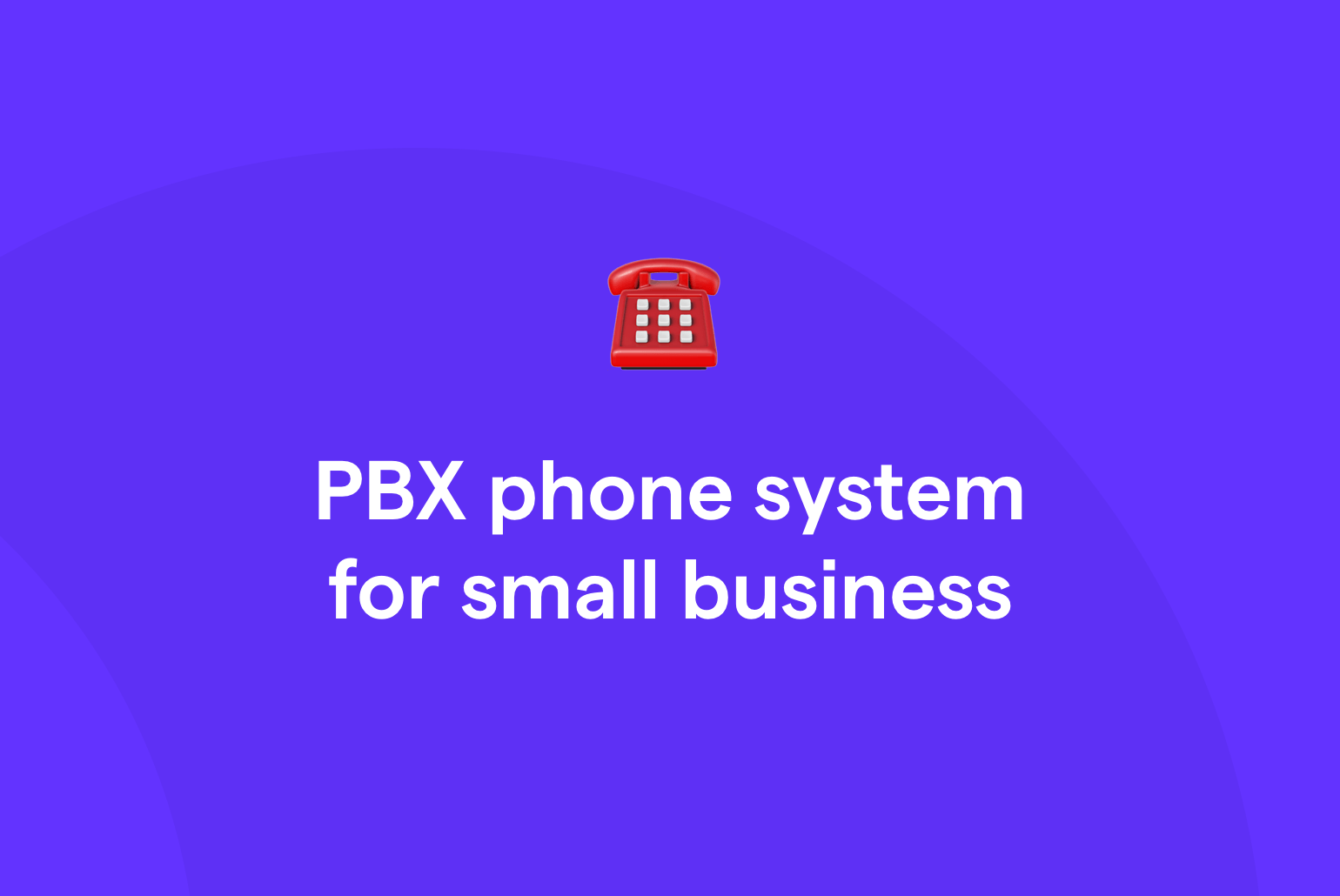A private branch exchange (PBX) is a business phone system that connects all the phones in an organization. With it, you can call customers and internal teammates through analog, digital, or IP phones.
But a PBX system isn’t always the right fit for fast-growing teams. This legacy phone option doesn’t offer the features you need from a small business phone solution — including SMS, voicemail to text, and remote work capabilities.
We’ve put together a resource that can help you make an informed decision. We’re exploring:
- The types of PBX phone systems
- 6 reasons to avoid PBX
- The specific cons of PBX
Curious about how other systems can serve your business better? We’re throwing in a list of seven features you can expect from a virtual phone solution.
Types of PBX systems for small businesses
PBX (an acronym for Public Branch Exchange; sometimes called PABX) is a legacy telephone system dating back to the 1960s. As you research this business phone solution, you’ll run into a few confusing acronyms, but keep reading as we’ll break down everything you need to know.
Now, let’s look at the different types of PBX systems.
Traditional PBX
A traditional PBX connects all the desk phones of a single organization. Team members can use their desk phones concurrently (at the same time) to make and receive phone calls. They can also make in-house phone calls for free if they want to reach someone in a different department.
Since traditional PBX systems were developed before digital telephony, they require physical telephone wires to connect each of your desk phones. For traditional PBX systems, a technician has to connect these wires to public telephone wires, then manually connect boxes and switches to distribute calls to other members of an office.
Because of all the hardware involved (and the long-term labor costs), analog PBX systems are extremely expensive to get up and running. It can cost up to $1,000 per employee just to set up the desk phones and build a phone closet to house your equipment. You’ll also have to pay every time you want to add new lines or upgrade your desk phones to newer models.
Onsite IP PBX
An onsite IP PBX is a digital phone system that runs through an internet connection. It allows you to make and receive phone calls from the internet using VoIP (voice over internet protocol) technology. In a nutshell, when you speak over the phone, VoIP technology converts your voice into digital data so it can be transmitted over the internet and heard by your recipient.
Since IP PBX phone systems can operate through WiFi, they can sometimes provide features that analog systems can’t — including call recording, custom extensions, and shared voicemail inboxes. But even if they don’t need copper wires, they still need physical hardware to run.
All of your PBX tools (switchboard, trunks, and lines) must be stored on-premise — which is why it’s called an onsite PBX. You’ll need a dedicated closet to this hardware, and you may need to hire a trained IT technician with experience in troubleshooting or installing older tech.
Hosted PBX
A hosted PBX literally ‘hosts’ your PBX system in a separate building from your business. This phone service provides similar features to an onsite PBX, with the added benefit of storing most of your hardware off-site by a third-party service.
The biggest benefit of a hosted PBX is not having to store physical phone lines at your office. However, you’ll still be tied to your desk through a landline or analog device. Plus, your call quality will be affected by the stability of your provider. If you work with an unreliable provider and experience an outage, you might not be able to communicate with customers at all.
One thing to be aware of you may hear that isn’t actually the case: not all hosted PBX systems are cloud PBX. In other words, some providers may refer to themselves as hosted PBX systems, but may not host their services in the cloud.
If you want a true cloud-based phone service to support your business needs that is far simpler to set up, you may want to look for a PBX alternative — including virtual phone solutions.
6 reasons to avoid PBX systems and choose a virtual phone instead
PBX is a legacy phone system that lacks the functionality you should expect from small business phone systems. Desk phones can tie you to a cubicle and stop you from taking work on the go. Plus, the monthly cost of hosted or on-site maintenance piles up as the years go by. Expensive installation costs can crush your brand’s ability to scale.
If you’re on the hunt for a business communication solution that can connect your office with less hardware and more advanced features, you’ll be happy to know there’s a better alternative — virtual phone systems.
Virtual phone systems let you make calls through a WiFi connection with no additional hardware required. That means you can access them on cell phones, laptops, and other internet-connected devices.
Plus, virtual phone systems can get up and running on the same day you buy them. You’ll never need to buy extra hardware (like desk phones) to add a new person to the team.
Thousands of small business owners have made the switch from PBX to virtual phone systems. Here’s why:
1. PBX phone systems cost more upfront
PBX systems cost more than any other phone solution. As mentioned earlier, it can cost up to $1,000 per user just during initial setup. That doesn’t include all the other fees, taxes, and equipment costs, either. If you run a larger team like a call center, the up-front costs can quickly add up.
But price is just the first consideration here. PBX also costs a lot of time to install, since you have to find enough IT specialists to put everything in place.
Thankfully, virtual phone systems are faster, cheaper, and less time-consuming to set up. While you might spend days or even weeks prepping your PBX, you’ll spend 15 minutes or less getting set up with a provider like OpenPhone. Plus, you won’t need to worry about installing new phone jacks to accommodate new users. Every new member of your team comes with a brand-new number; they can use their existing hardware (phones, tablets, laptops, etc.) to start making and taking calls immediately.
2. PBX phones are more expensive annually
Apart from their expensive installation costs, PBX phones also require a lot of maintenance. You’ll likely require ongoing support for upkeep, upgrades, and troubleshooting unless you have a member of the team who has experience working with PBX. Even then, hardware repairs don’t come cheap.
And keep in mind PBX systems don’t last forever. You’ll need to replace your PBX box every 10 – 15 years, which adds additional (and unnecessary) expenses to your budget.
A virtual phone system doesn’t require annual maintenance, dedicated IT teams, or semi-yearly equipment replacements. All you need is a subscription to the platform. Using the right virtual phone provider, you can instantly access updated software, responsive support staff, and a reliable phone service with extremely high uptime.
Since you won’t have to pay thousands of dollars to maintain your legacy system, you can easily scale as your business grows and upgrade to new features as necessary.
3. PBX phones are a productivity killer
Everything about a PBX is manual. From plugging in wires to troubleshooting bad quality, it’s almost impossible to automate repetitive tasks and take more work off your plate.
This applies to implementing your tech stack as well. Unfortunately, PBX systems are rarely cooperative with other third-party apps. Streamlining workflows through phone integrations requires a ton more legwork to get up and running. Plus, depending on the PBX provider you’re using, integrations may not be possible at all.
This is the exception rather than the rule. Most virtual phone systems, including OpenPhone, offer simple integrations with third-party providers. OpenPhone also lets you automate specific touchpoints such as appointment confirmation texts (more on this later).
4. PBX systems don’t let your team text
Most PBX system systems don’t allow you to text customers at all — either through SMS or MMS.
On the other hand, virtual phone systems support internal and external messaging between you and your customers. With OpenPhone, you can send text-based messages to customers with SMS, or attach multimedia like pictures, videos, GIFs, and documents.
5. PBX phones make following up far slower
PBX phones offer the option to play back voice messages or check the numbers of previous callers. However, they won’t show you any other points of contact or keep any conversation histories organized so your team can review and follow up with someone.
Virtual phone solutions give you a clear look at every point of contact between you and individual callers.
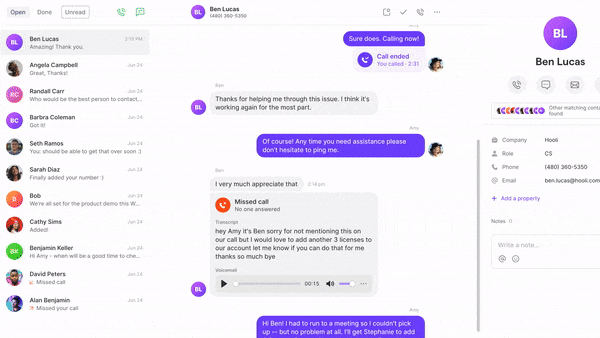
Solutions like OpenPhone keep all your contacts’ conversation history within a single thread — including texts, calls, and voicemails — so you can easily follow up on questions and comments. If you have shared numbers with multiple team members, everyone can access and review the same centralized contact history.
6. PBX is stuck in the past (and on the desk)
Team members might have to leave their desks or take calls with them out in the field. Unfortunately, PBX won’t be much help — you can only use your phone system from inside your business network. That means you won’t be able to work from home or take calls with you on the go.
You could always try to forward calls from your desk phone to your cell phone — but you still can’t text from your business number. You also won’t have access to any of the conversation history with your contacts as your customers expect that they shouldn’t have to repeat information. 71% of consumers believe that companies should collaborate on their behalf so they don’t have to repeat themselves.
Starting to get the feeling that PBX is obsolete? You’re not alone. PBX just wasn’t made for these times. While you may be able to use virtual receptionists instead of switchboard operators, you won’t be able to:
- Check real-time analytics
- Easily work together with any teammates to provide a better customer experience
- Set up call routing outside the network
- Use call transfers for external numbers
Phone lines from OpenPhone let you do your work from anywhere with an internet connection. You can access a full set of analytics, route calls to numbers inside and outside your business, and text from any number you happen to own — including toll-free phone numbers.
7 features you should expect in a phone system
Virtual phone systems offer better prices, features, and integrations than any legacy PBX solution. However, not all providers are created equal. It’s important to select the right VoIP phone system that provides everything your business needs to grow.
Here are the seven things you should expect from your virtual phone provider:
1. Streamlined options for texting
Most VoIP providers offer support for SMS and MMS. However, only the best provide options to automate specific touchpoints with customers.
You can automate your business texting on OpenPhone with four different features:
- Snippets give you the ability to save and store canned responses to frequently asked questions. You can enter ‘/snippets’ into your message box to bring up a list of message templates or save a new one for future use.
- Scheduled text messages let you reach out to contacts at a specific time. This is especially useful if you want to follow up with a customer or request a review.
- Auto-replies instantly touch base with your contacts after you miss a call. You can set up auto-replies to let customers know you got their message and will be back soon to help “(i.e., “Sorry we missed you! How can we help?”). Your callers will appreciate your immediate point of contact, while you can stay on-task with whatever you’re doing.
- OpenPhone integrates with third-party apps that create automated workflows between customers and your brand. Do you run an appointment or service-based company? You can set up a workflow that automatically sends appointment confirmation texts after someone books time with your business on your website
2. Unlimited calling in the US & Canada
PBX systems don’t always provide unlimited (or free) outbound calls. With some providers, you only get a set amount of call minutes or need to pay for every outbound call.
Your virtual phone service provider should make domestic calls simple, easy, and most of all, free. With OpenPhone, you can access unlimited calls in the US and Canada from almost anywhere in the world. Everyone on your team can make or take calls at the same time so you can reach customers as quickly as possible.
Need to reach callers outside of North America? Check out our competitive international rates.
3. Shared numbers
Work together as a team to develop stronger relationships with customers using shared numbers. For example, you can add all members of a specific department (i.e., Sales or Customer Service) to a single shared number. Each member of the phone number shares the same contact inbox, meaning they can stay up to date on who’s doing what. Plus, everyone on the shared number will get notified of incoming calls. The line will ring until someone picks up, which means there’s always someone around to chat with your customers.
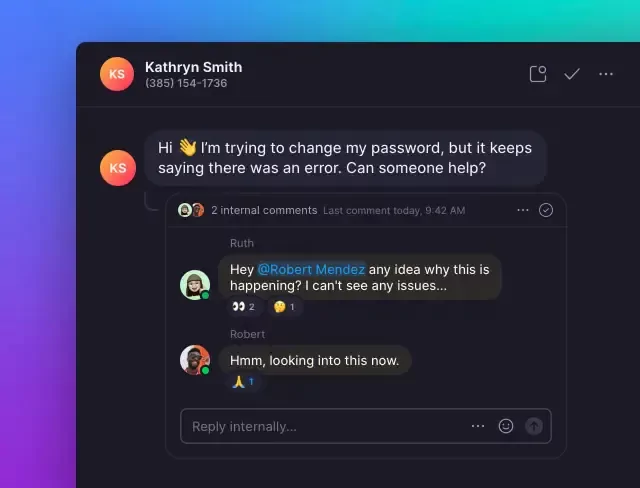
With OpenPhone, you can add comments (that are visible only to your team) to any voice message, text, or call recording so you can collaborate with your team and assign out tasks.
4. Call recordings
Need to remember something a customer said? Or keep a record of your interactions for training or legal purposes? Virtual phone solutions make it easy to record and store any calls on the go.
OpenPhone offers two different ways to record calls on your business phone: on-demand and automatic.
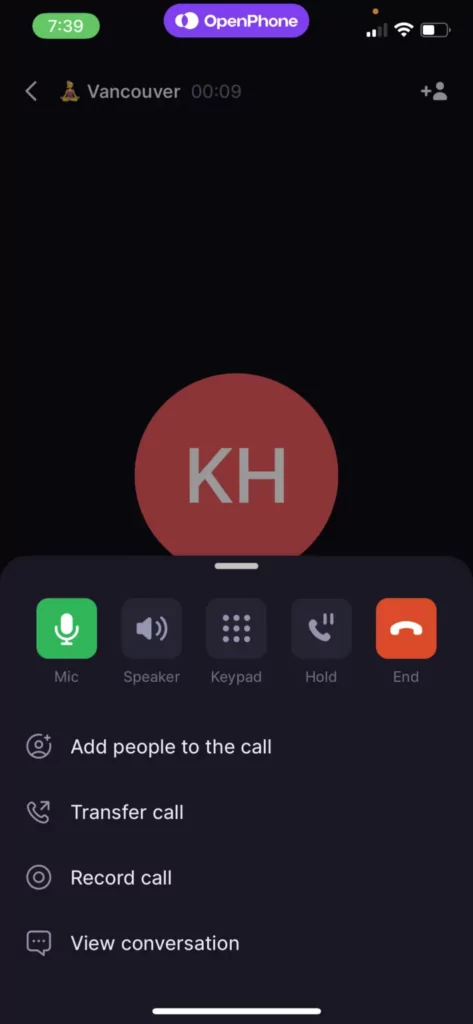
With on-demand call recording, you can press ‘Record’ at the start of each session to create a recording of your call (when calling from your computer, smartphone, or tablet). And if you’re on OpenPhone’s Business or Enterprise plans, you can set up auto-record in the web or desktop app to record all calls on a specific number.
5. Mobile, browser, and desktop apps
The last thing you need as a small business owner is to be tied down to a desk or cubicle. Your phone service provider should offer the flexibility you need to take work with you on the devices you’re already using.
OpenPhone offers browser, desktop, and mobile apps that are accessible to Android and iOS devices. You can make or take phone calls from your smartphone, laptop, or home computer.
Then, when you’re ready to clock out for the day, you can set business hours that send callers straight to voicemail when your business is off. If anyone calls outside of your business hours, your contacts will have clear expectations for when you’ll be back. Plus, you won’t have to worry about unexpected calls in the middle of the night.
6. Phone menus
While PBX systems offer basic phone menus (also known as auto attendants) to help callers get where they need to go, virtual phone services can make your process more accessible with an IVR (interactive voice response).
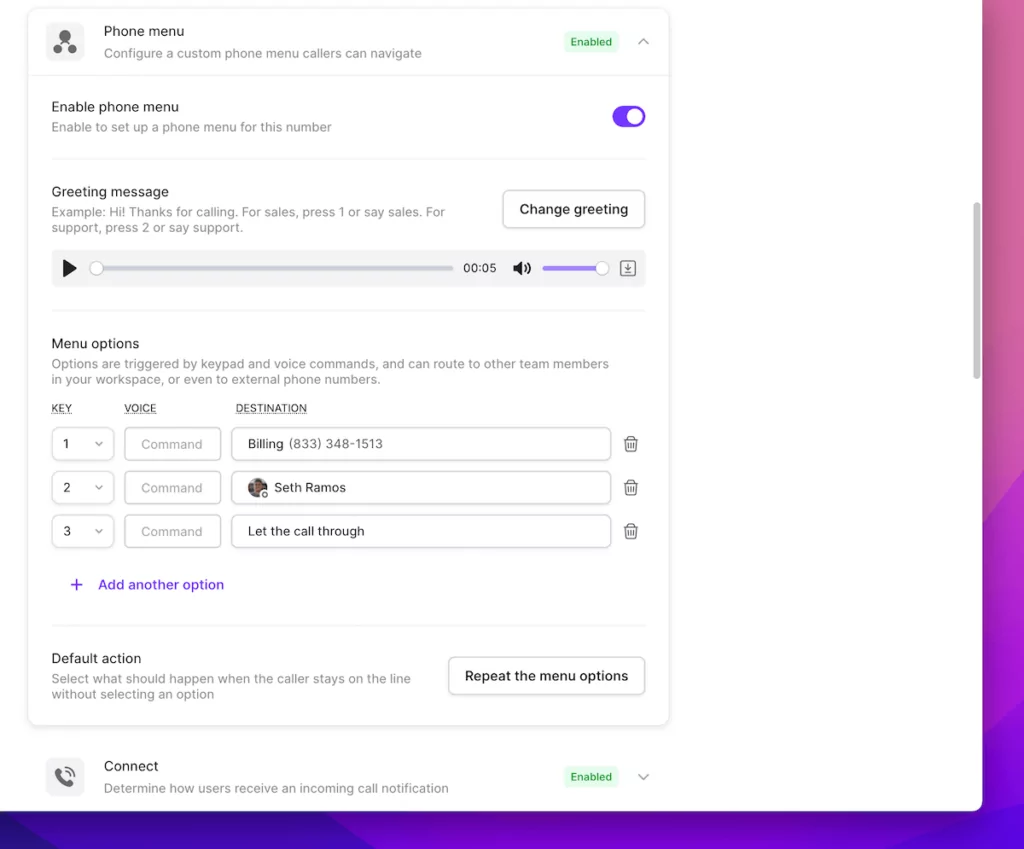
On our Business plan, you can have any of these phone menu options:
- Route calls to an OpenPhone number
- Route calls to an external number
- Let calls go through to the number they called (‘If you want to speak with Customer Service, simply stay on the line’)
- Playback an audio recording containing additional information
- Send callers straight to voicemail during business hours
- Send callers to a specific teammate in your workspace
Phone menus are a win/win for your team and your customers. Callers spend less time figuring out who they need to call and more time on the line with the right person. This speeds up your handle time and takes unnecessary tasks off your plate.
7. Voicemail transcripts
Traditional PBX hardware can store audio voicemails, but many don’t translate voice messages to text. Thankfully, virtual phone solutions offer audio recordings and voicemail transcripts of the messages callers leave behind.
With OpenPhone, you can use voicemail transcripts and audio recordings to get up to speed on what your caller(s) need. If you don’t always have OpenPhone, but need to check in using other tools you already use, you can automatically push all transcripts into your email inbox or any Slack channel.
What are the cons of a PBX system for small businesses?
Want to check the limitations of PBX at a glance?
These are the cons of a small business PBX system:
- Higher upfront costs
- More difficult to scale if you use hardware
- Expensive maintenance and upgrades
- More time to get up and running
- Likely require ongoing support from IT for maintenance
- Complicated troubleshooting
How scalable is a PBX system?
Since a PBX system for small business requires additional hardware and trained technicians to connect devices, they are far less scalable than other business phone solutions.
Thankfully, virtual phone systems allow you to add new lines or numbers without purchasing more hardware. With OpenPhone, every new user on your phone plan comes with a free local or toll-free number — no Ethernet cables or desk phones required.
Build better relationships with your customers using OpenPhone
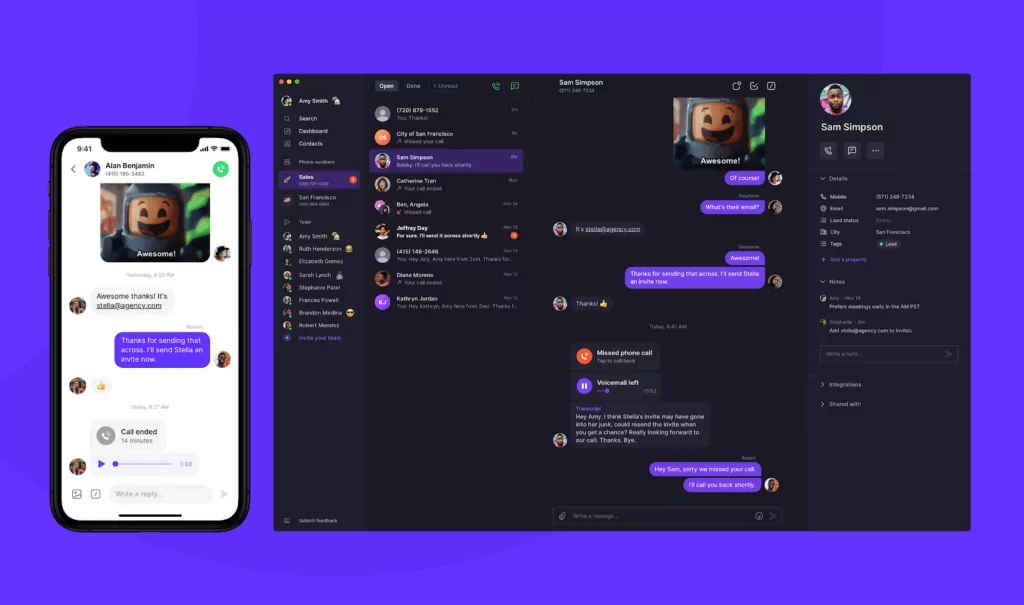
By now, you may be wondering if you can move your existing business number(s) away from your current PBX system. Good news — you can! You can take advantage of all the benefits a virtual phone offers without losing your existing business phone number.
With OpenPhone, all you have to do is complete a two-minute porting form to get all seven features mentioned above, as well as a few cherries on top. These include:
- Integrations with the tools you’re already using
- The ability to set a caller ID for any business number so your customers can instantly recognize you whenever you call
- Group calling (coming soon!)
Take OpenPhone on a test drive with a seven-day free trial.
